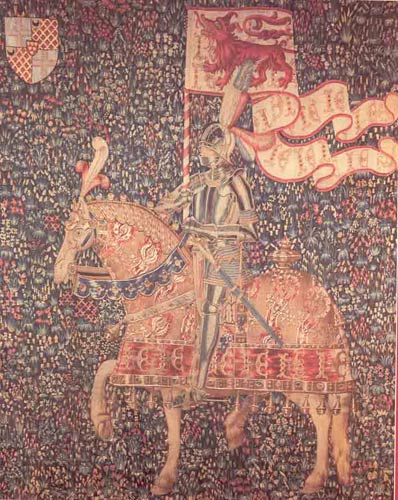A badge is a distinctive device or emblem assumed as a mark of recognition by an individual or family and often worn as a symbol of loyalty and allegiance. Badges used in this way are a particularly British heraldic tradition that became fashionable in the late 14th century, at the court of Edward III (1327-1377). In the later Middle Ages it became customary for the devices or badges of kings and the nobility to be worn by their retainers and household servants as visible affirmations of allegiance. (Spencer, pg 278) Edward III was particularly dedicated to chivalric tradition and with this renewed devotion to chivalric ideals, came a resurgence in the interest of heraldic display within the nobility.
The purpose of this article is to discuss heraldic dresses for women, with a view to being of use to medieval re-enactors who wish to create these types of garments. Even though depictions of such dresses appear on numerous period sources: armorial rolls, funereal monuments, brass effigies/inscriptions and illuminated manuscripts, it must be stated at this point that there appears to be little concrete evidence to support the concept of gowns displaying heraldry on an entire garment in a fashionable context. Currently, the belief is that these representations are primarily for symbolic identification, as many noble personages were instantly recognisable to the populace solely by their heraldry in what was largely an illiterate age. The use of heraldry in these art forms would have left no doubt as to the identity of the persons being portrayed, which explains its inclusion on items seen by people who may not have had the benefit of knowing the person depicted firsthand.
Period examples of heraldic standards are found represented across nearly every art form of the medieval period. They appear on many famous tapestries, on rolls of arms, on embroiders, in patent of arms documents, funereal certificates and are very frequently depicted in illuminated miniatures.

Jean de Dillion Tapestry - c1481
In order to create a ceremonial atmosphere at baronial and kingdom court events, we have fashioned personal standards bearing the St Florian Bottony Cross and our individual devices. This has allowed our group to make impressive and cohesive displays when decorating halls or tourney fields. Everyone in our Barony is encouraged to display their devices on a standard, even if your device isn’t registered - yet!
On the medieval battlefield and at tournament, a knight is frequently depicted wearing an outer garment over his armour that often bears an armorial display.This display allows identification of the knight when his features are obscured by his great helm in the chaotic environment of the medieval battlefield.The design of the garments varies quite considerably over different periods and cultures.The following is a brief description of some different styles, designed to give the SCA newcomer an introduction and is by no means complete.

